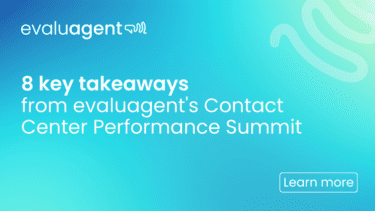8 key takeaways from evaluagent’s Contact Center Performance Summit


Missed out on our Contact Center Performance Summit? We’ve collated some of the biggest ‘ah-ha!’ moments from the day here for easy browsing and sharing. It’s the perfect way to catch what you missed if you’re short on time.
In his forward-thinking keynote on predictive metrics, Ben Cave, Product Director at evaluagent, shared an eye-opening prediction of how AI could influence customers and contact centers alike.
‘Agentic AI’ – that is, AI as an assistant – could soon create a scenario where your customer conversations aren’t human at all. From requesting refunds to renewing insurance policies, customers are likely to task AI assistants with all the jobs they don’t want to do – and lots of them will involve the contact center.
Routine enquiries may soon barely touch humans at all, which leads us nicely onto…
Host of Get out of Wrap podcast, Martin Teasdale highlighted that agents are at risk of burnout. Why? Because the complexity of today’s customer environment, coupled with contact centers increasingly filtering more straightforward, transactional conversations onto AI agents and chatbots, means they no longer get a break.
If agents are spending all day, every day handling complicated, difficult interactions, you’re likely to see turnover spike and disengagement on the rise.
But you can combat this. Rather than using this ‘free time’ AI agents have granted to drive up productivity, Martin suggests building in more deliberate breaks. In the long term, agents will feel more refreshed and ready for their next round of interactions.
AI expert Erica Farmer had plenty of great insights to share on how you can build an AI-human blended team. Among them was the fact that you need to combat the idea of AI as a threat to your team.
While AI represents change, it doesn’t instantly mean replacement. It’s vital to have ongoing conversations with your team about AI’s place in the contact center, what AI is good at and the less engaging work it can relieve them of, but more importantly, what their strengths are and why they still have a crucial role in the customer experience.
“Buried underneath fixes, we are going to miss opportunities to truly innovate our customer experience.”
That might sound initially counter-intuitive, but CX expert Katie Stabler goes into detail about why this is holding you back. For a start, this approach tends to be purely reactive and narrow in focus. Finding and erasing friction isn’t a bad thing, but it also isn’t contributing the maximum potential to the bigger picture.
Instead, be more visionary. Ask yourself: Is this really moving us, and our customers, forward?
evaluagent experts Rob Wilkinson and Simon Poland ran a session on how to make AI roll out a success in your contact center.
Of the many great points they made, one was having clear goals and governance in mind before you scale your project. You should start small with AI, measure its impact, understand the successes and opportunities for improvement, and revisit your plan (if necessary).
A pilot provides a great opportunity to benchmark where you are and see what ‘good’ looks like before you ramp up roll out to the rest of your contact center.
Across our panel of speakers from Ubisoft, First Central and AllClear Insurance, there was a broad consensus that 2025 will be all about being more proactive for agents.
Ubisoft is keen to leverage AI as a way to surface knowledge to their players and deflect interactions from ever reaching the contact center, helping to minimize workload.
Meanwhile, AllClear are looking to use AI to better serve agents with learning and informational materials before they need to ask. It’s less about training agents to have encyclopedic knowledge, and more about providing great service.
Ben Cave shared how leveraging predictive metrics for sentiment analysis and NPS can open doors to efficiency and greater customer satisfaction.
He illustrated this with a simple example. An older customer is more likely to have a strong preference for speaking to a person over the phone. You risk frustrating them by trying to funnel them through self-service and chatbots. Meanwhile, Gen Z and Gen Alpha are more likely to avoid calling altogether, since they prefer online channels.
By analyzing the preferences your customer database expresses and tailoring their experience, you can create better outcomes for your contact center and customers. You should see fewer frustrated customers, with conversations being handled according to their preferred communication style.
Scott Stephenson, CEO of market-leading transcription software Deepgram, closed out the day with a great reminder of the importance voice has to play in the contact center industry. While voice transcription and its AI analytics potential isn’t yet widespread, the data shows that those who are prioritizing this technology are getting ahead.
In fact, transcription can be a cost-saving strategy. According to one study by McKinsey, companies using speech and text analytics were able to reduce average handle time by 40%. The potential is there – you just need to start with a strong use-case for it.
Share your key takeaways with us on LinkedIn! Tag us @evaluagent or use the hashtag #evaluagentsummit24

Get more in-depth guidance to making AI a success in your contact center. Download our free guide to the ins-and-outs of operations, choosing vendors, and launching your pilot scheme.
Download now